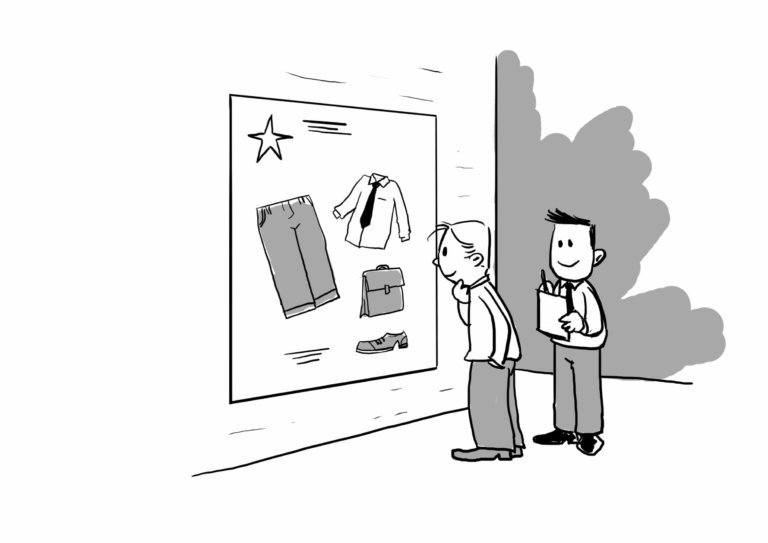Today, most markets are saturated, and companies are fighting for the same customers. This is why organisations should no longer aim for customer satisfaction but rather delight. But how can you delight your customers so they remain loyal advocates?
With fewer and fewer differences between the products and services offered, many companies have realised that they can – and should – differentiate by improving their customer experience. Here are twenty ways to get started, together with best-in-class examples, but I’d love to hear how you delight your own customers and turn satisfaction into loyalty.
1. Deliver Exceptional Customer Service
Exceptional customer service is the first essential step to plan. It’s about creating an unforgettable positive experience that fosters loyalty and word-of-mouth promotion.
A study by American Express found that 70% of consumers are willing to spend more with companies they believe provide excellent customer service.
Nordstrom sets a high standard in this regard, famously accepting the return of car tyres they never sold to satisfy customer expectations and demonstrate their commitment to service.
This example underscores the importance of empowering employees to make decisions that prioritize customer satisfaction, fostering a strong customer-centric culture.
Another company renowned for its customer service is Zappos, an online retailer. The company has a 365-day return policy and is known for going above and beyond for customers, such as when a customer service representative sent flowers to a customer who had lost her mother.
2. Personalise the Experience
Personalization makes customers feel uniquely valued and understood. It is the second most important way to delight your customers.
According to a report by Epsilon, 80% of consumers are more likely to purchase from a brand that provides personalized experiences.
Spotify exemplifies personalization by using sophisticated algorithms to tailor playlists to individual tastes, improving user engagement and increasing subscription retention rates.
This approach demonstrates how leveraging data and technology to understand and anticipate customer preferences can significantly enhance the user experience.
Netflix offers another excellent example of personalization. It analyzes viewing patterns to recommend shows and movies, enhancing user satisfaction and retention. I bet you’ve clicked on many of their suggested titles. I know I have!
3. Offer a Loyalty Program
Loyalty programs reward and encourage repeat business, creating a tangible incentive for ongoing patronage.
This strategy boosts sales and delights customers by enhancing their emotional connection with the brand and making members feel valued and special.
Sephora’s Beauty Insider program offers a compelling example with tiered rewards, including birthday gifts, exclusive discounts, and early product access.
Any way that makes your customers feel special will also increase their loyalty and advocacy.
4. Maintain High Quality and Reliability
A company’s commitment to quality reassures customers and confirms their purchase decision, fostering trust and satisfaction.
Especially where larger and exceptional purchases are made, your customers need ongoing reassurance that they made the right decision.
Toyota is renowned for the durability and reliability of its vehicles, which has cultivated a loyal customer base that trusts the brand to meet their expectations with every product. This reputation for quality attracts new customers looking for long-term value and minimal hassle.
5. Responding Quickly will Delight Your Customers
We live in a fast-paced world where responsiveness is a key determinant of customer satisfaction.
The average response time for emails should be between 12 and 24 hours. That said, nearly half of all customers (46%) expect companies to respond faster than 4 hours, and 12% expect a response within 15 minutes or less! (Source: Influx)
JetBlue is recognized for its responsive customer service on social media, often replying to queries on X (Twitter) within minutes.
This level of responsiveness to quickly address customer concerns showcases how timely communication can transform customer perception and mitigate potential dissatisfaction.
6. Ensure a Seamless Omnichannel Experience
A perfect integration across all customer touchpoints—from online to in-store—provides a unified brand experience for customers. Making the customer’s journey as effortless as possible is a sure way to delight your customers every time.
According to McKinsey, many companies try but fail to build an omnichannel experience for every channel and customer. Their research shows that more than half of customers engage with three to five channels during each journey toward making a purchase or resolving a request. Therefore, their recommendation is to limit focus to the top two or three cross-channel customer interactions.
Walmart’s use of technology to allow customers to pick up online purchases in-store the same day is an excellent example of this strategy. It shows how businesses can use their omnichannel capabilities to increase convenience and streamline the customer journey.
7. Actively Use Customer Feedback
Feedback is a crucial element of improvement, so incorporating it into product development and service enhancements demonstrates a commitment to continuously improving the customer experience.
According to a study in the Harvard Business Review, customer-ideated products perform 20% better than those developed with customer input.
An excellent example of this strategy is the Lego Ideas portal. This inspires new sets and is an innovative approach to product development. It encourages active customer participation in the brand’s creative process through its Lego-building contests. The new ideas submitted by others are then voted on, further developing product relevance and customer attachment to the brand.
8. Employ Surprise Tactics to Delight Your Customers
Unexpected gestures can significantly boost customer perceptions of a brand.
Random acts of kindness or free products and services can create powerful emotional connections with customers.
KLM Airlines once conducted a “KLM Surprise” campaign, providing personalized gifts to passengers. This created memorable experiences that were shared on social media and went viral.
Such events showcase the power of surprise in earning customer goodwill and enhancing brand visibility. They can significantly enhance customer perception of a brand, making these moments highly shareable and boosting brand visibility.
9. Provide Proactive Customer Support
Proactive customer service anticipates buyers’ needs (or problems) before they are even aware of them or think about contacting you for assistance.
Examples include immediately alerting customers about shipping delays or service interruptions. Anticipating and resolving customer issues before they arise delivers a hassle-free customer experience.
Although you may wonder if people dislike being contacted by brands spontaneously, research by InContact shows that 87% of U.S. adults want to be contacted proactively by an organization or company, especially when problems arise. This avoids the frustrating and often angry outreach when customers do not receive the expected product or service.
Adobe regularly sends proactive tips based on user behaviour. This approach helps customers better use their software and prevents easily avoidable frustrations. It improves the user’s competence and enhances satisfaction with the product.
10. Educate Your Customers
There are five main benefits to providing customers with the knowledge they need to use your products better:
1. Increased Customer Loyalty and Retention
2. Improved Customer Satisfaction and Experience
3. Reduced Support Costs and Increased Efficiency
4. Increased Product Adoption and Revenue
5. Competitive Advantage
In addition, according to research by Intellum-Forrester, a customer education program can boost customer retention by 7.4%.
Some well-known examples of customer education include Canva and Slack, which have both leveraged video to connect with their customers and take the mystery out of what their services entail.
Apple offers free workshops in their stores and the opportunity for customers to view devices and get the information they need about the products they see in front of them.
Home Depot’s DIY workshops teach practical home improvement skills, empowering customers to undertake projects confidently. This educational approach drives sales of DIY products and builds a community of loyal, engaged customers.
11. Offer Flexible Return Policies
Flexible return policies alleviate customer fears about potential post-purchase regrets, making them more willing to buy. By offering generous return terms, brands can reduce the perceived risk of transactions. It can also tip the balance when the choice between two suppliers is not obvious.
Zappos, for instance, provides a 365-day return policy with free return shipping, setting a high standard in online retail. This policy is rooted in their ethos of customer-first service and has significantly enhanced customer trust and satisfaction. The policy encourages frequent purchases and drives word-of-mouth recommendations due to the hassle-free nature of returns.
Amazon and Ikea also both offer very generous return flexibility. Amazon often makes refunds before receiving the goods, and Ikea offers no-question returns during the complete guarantee period. (I myself returned a mattress with squeaky springs after five years!)
Nordstrom also has a no-questions-asked return policy, ensuring customers feel confident in their purchases. This customer-centric approach has led to exceptional brand loyalty and has set Nordstrom apart as a leader in customer service.
The success of such policies demonstrates the importance of minimizing purchase risk. According to a survey by Narvar, 96% of customers would shop with a retailer again if they had an “easy” return experience.
12. Use Social Media Effectively
Social media provides a direct communication channel between brands and their customers, allowing businesses to effectively engage, resolve issues, and build brand loyalty.
Glossier, a beauty brand, has mastered the art of social media engagement. It has fostered a loyal online community by actively responding to customer queries, sharing user-generated content, and showcasing its products creatively.
Another example is Nike, whose strong social media presence encourages customers to share their fitness achievements and tag the brand, creating a sense of community. The company also responds to customer inquiries quickly and features inspirational athlete stories that resonate with its audience.
A study by Sprout Social showed that 83% of people like it when brands respond to questions on social media, and 68% have greater brand loyalty to companies that engage with them on social media.
13. Create Community Involvement
Customers increasingly align with brands that reflect their values and contribute positively to society. By actively involving themselves in local communities, brands can build a loyal customer base that feels connected to their social mission.
Patagonia, for example, donates a percentage of its profits to environmental causes and encourages its customers to engage in activism, fostering a strong sense of shared values.
Ben & Jerry’s, the ice cream company, is also known for its activism and involvement in social justice issues. Its “Caring Dairy” program helps farmers implement sustainable practices and promotes fair trade practices and climate change initiatives.
Cone Communications’ study revealed that 87% of consumers would purchase a product based on a company’s advocacy concerning social issues.
14. Exclusive Offers will Delight Your Customers
Exclusive offers make customers feel valued and part of a select group, increasing brand loyalty.
American Express’s strategy of offering cardholders pre-sale concert tickets and unique experiences adds significant value to its services, enhancing customer loyalty through perceived exclusivity.
Costco’s membership-only model provides access to exclusive deals and high-quality products at discounted prices, which creates a sense of privilege and motivates customers to renew their membership annually.
According to research by Accenture, 59% of customers believe personalized offers based on past purchases influence their shopping decisions.
15. Facilitate Easy Navigation
A well-designed website or mobile app with intuitive navigation makes it easier for customers to find what they’re looking for, thus improving their overall experience.
Amazon’s 1-Click ordering feature simplifies the buying process, reducing friction and enhancing customer satisfaction. The “Recommended for You” section also helps customers discover products they might like, adding value to their shopping journey.
Apple’s website and physical stores are designed for simplicity and easy navigation. Their Genius Bar appointments and clear product categorization make it easy for customers to get assistance or find their needed products.
Gartner reports that organizations prioritizing customer experience design outperform their competitors by 25% in satisfaction metrics.
16. Celebrate Customer Milestones
Acknowledging customer milestones, such as anniversaries or significant purchases, personalizes the customer experience and fosters a deeper connection.
Emirates Skywards, for instance, rewards its frequent flyers with bonus miles on membership anniversaries, making them feel recognized and appreciated.
Starbucks sends personalized messages and offers free drinks to loyalty members on their birthdays, creating a sense of personal connection and encouraging members to continue engaging with the brand.
Accenture’s recent research proved the power of personalised messaging. The company reported that 75% of consumers are more likely to buy from brands that recognize them by name, recommend products based on past purchases, or know their purchase history.
17. Implement Advanced Security Features
With hacking and viruses a permanent threat, advanced security features reassure customers about the safety of their data and transactions, building trust and enhancing brand loyalty.
JPMorgan Chase, for example, has invested heavily in cybersecurity to protect customer information. It uses multi-factor authentication and encryption to safeguard online banking transactions.
Google’s advanced security features include two-step verification and alerts for suspicious activity, which provide users with additional peace of mind regarding their accounts.
While I admit to being frustrated at times with overzealous authentication practices, a survey by PwC found that 85% of customers will not do business with a company if they have concerns about its security practices.
18. Offer Comprehensive Training for Staff
Well-trained staff can handle customer issues more efficiently and deliver exceptional service consistently.
The Ritz-Carlton invests heavily in training programs to ensure their customer service remains top-notch across all properties. Employees are empowered to spend up to $2,000 per guest to resolve issues, allowing them to take swift action and provide an unparalleled service experience.
Southwest Airlines’ “University for People” trains employees in customer service excellence, emphasizing teamwork, empathy, and problem-solving to improve passenger experience.
A study by the American Society for Training and Development (ASTD) found that companies with comprehensive training programs enjoy 24% higher profit margins than those with less training.
19. Regularly Update Product Features
Regular updates keep products fresh and engaging, meeting constantly evolving customer needs.
For example, Tesla’s over-the-air software updates enhance vehicle performance and safety features, ensuring that owners receive continuous value from their purchase without visiting a service centre.
Microsoft regularly updates its software to improve security and functionality across its suite of products. This enhances the user experience and reduces potential technical issues.
A Gartner report shows that 89% of companies compete primarily on customer experience today, emphasizing the importance of continuous product improvement to meet customers’ ever-changing desires.
20. Conduct Regular Follow-Ups
Regular follow-ups after a purchase or service show customers that a business values their business and satisfaction.
Auto dealerships are a good example; they often contact customers post-service to check on vehicle performance and service quality, reinforcing a positive customer relationship.
American Express regularly follows up with customers via surveys and personalized emails after resolving a dispute or issue, ensuring the customer feels valued and heard.
According to Salesforce, 89% of customers are more likely to make another purchase if they are satisfied with the follow-up after an initial purchase.
Conclusion
In today’s competitive landscape, delighting your customers is not just a good-to-have objective; it’s essential for sustainable business success. By investing in these strategies and tactics, companies can build stronger customer relationships, enhance loyalty, and differentiate themselves in the marketplace.
It is interesting to note that many of these suggestions are proactive actions, making it essential to know and understand your customers as deeply as possible.
These suggested tactics represent a strategic opportunity to transform interactions into memorable experiences that delight your customers and lead to increased brand loyalty and advocacy.
If you plan to increase your customers’ delight, we should talk. Book time on my agenda and learn three atomic steps that can quantum impact your business!







